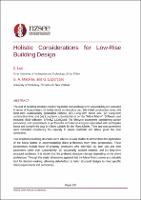Holistic Considerations for Low-Rise Building Design

Download
Date
2024-04-09Authors
Holland, William
Gray, Caleb
Loporcaro, Giuseppe
MacRae, Gregory
Metadata
Show full item recordAbstract
Two low-rise residential structures, a single-storey residential structure (SSRS) and one triple-storey structure (TSS), are initially described using building information modelling (BIM) software. The structures are then evaluated in terms of four parameters: (i) direct construction cost; (ii) construction time; (iii) short-term sustainability (embodied carbon); and long-term sustainability (resilience) as per the "Mana Matrix". Software used included: Revit BIM; BRANZ LCAQuick (for lifecycle assessment considering carbon emissions); and spreadsheets to perform the convolution integrals associated with earthquake losses, and compile the data in a form suitable for the Mana Matrix. Time and cost parameters were estimated considering the capacity to source materials and labour given the time constraints. Losses considered the ultimate limit state (ULS) and horizontal design action coefficient (𝐶%) for each structure using New Zealand standard (NZS1170.5:2004).
Client preferences from three perspectives, are included by providing different weightings to each of the factors in the Mana Matrix. This perspectives included those of property developers who prioritised (a) both cost and time parameters rather than
sustainability, (b) sustainably sourced material, and (c) long-term structural resilience. It is shown that the preferred structure changes depending on the client preferences.
